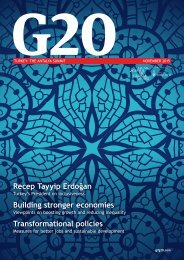G20 china_web
Create successful ePaper yourself
Turn your PDF publications into a flip-book with our unique Google optimized e-Paper software.
Climate change and green finance<br />
KEY TAKEAWAYS<br />
Much more must be done to achieve<br />
the emissions reductions required<br />
<strong>G20</strong> meetings should take stock<br />
and make public promises<br />
ERIC KAYNE/INVISION FOR NRG/PA IMAGES<br />
The accomplishments and<br />
limitations of the 2015 Paris Agreement on<br />
climate change have been widely debated.<br />
The next few years will reveal how well the<br />
critical missing transparency, accountability<br />
and finance can be addressed.<br />
Despite the significant and broadly<br />
shared ambitions contained in the<br />
agreement and its associated national<br />
commitments, even in the most optimistic<br />
scenario of all countries meeting their<br />
Paris pledges, much more must be done to<br />
achieve the emissions reductions required<br />
to meet the stated target of keeping<br />
additional global warming at levels around<br />
2 degrees Celsius. More cuts before and<br />
after 2030 are required. Which national,<br />
intergovernmental and transnational forums<br />
are well suited to continue discussions and<br />
actions on raising ambitions? The <strong>G20</strong> is<br />
certainly one.<br />
The world’s largest economies are<br />
mostly the world’s largest emitters. The <strong>G20</strong><br />
countries – plus the other members of the<br />
European Union, which also participates<br />
in <strong>G20</strong> summits – constituted almost 75 per<br />
cent of global carbon emissions in 2015.<br />
Burning coal also contributes a mighty share<br />
of other emissions, such as sulphur dioxide,<br />
nitrogen oxides and particulates. There is<br />
no better place to put coal on the table, at<br />
the centre of the global agenda, than a <strong>G20</strong><br />
meeting in China.<br />
Several <strong>G20</strong> countries are significant<br />
producers of fossil fuels, particularly<br />
coal (see table). All have an interest and<br />
an obligation to incentivise increased<br />
investments in many mitigation strategies<br />
and technologies, to further redesign<br />
industrial activity and to retrain workers<br />
The carbon capturing WA Parish power plant in Fort Bend County, Texas, USA.<br />
<strong>G20</strong> member<br />
Overview of share of coal<br />
in <strong>G20</strong> economies<br />
Coal<br />
production<br />
(Mtoe,<br />
2015)<br />
Coal<br />
exports<br />
(million<br />
tonnes,<br />
2013)<br />
Primary<br />
energy<br />
consumption:<br />
coal (Mtoe,<br />
2015)<br />
Coal<br />
share of<br />
electricity<br />
generation<br />
(2013)<br />
Argentina – – 1.4 2.4%<br />
Australia 275.0 336.1 46.6 64.7%<br />
Brazil 3.4 – 17.4 3.8%<br />
Canada 35.8 39.1 19.8 10.0%<br />
China 1,827.0 5.6 1,920.4 75.4%<br />
France – – 8.7 4.4%<br />
Germany 42.9 – 78.3 46.8%<br />
India 283.9 – 407.2 72.8%<br />
Indonesia 241.1 410.9 80.3 51.2%<br />
Italy – – 12.4 16.8%<br />
Japan 0.6 – 119.4 32.4%<br />
Korea 0.8 – 84.5 41.4%<br />
Mexico 7.0 – 12.8 10.8%<br />
Russia 176.6 140.8 88.7 15.2%<br />
Saudi Arabia – – 0.1 0.0%<br />
South Africa 142.9 74.6 85.0 93.7%<br />
Turkey 16.4 – 34.4 26.6%<br />
United Kingdom 5.3 – 23.4 37%<br />
United States 455.2 106.7 396.3 39.9%<br />
European Union 145.3 – 262.4 27.5%<br />
Notes: Uses base years for which data for all <strong>G20</strong> members are available.<br />
Mtoe = millions tonnes of oil equivalent.<br />
Sources: World Bank, BP Energy Outlook, Eurostat, and Organisation<br />
for Economic Co-operation and Development.<br />
192 <strong>G20</strong> China: The Hangzhou Summit • September 2016 G7<strong>G20</strong>.com
















